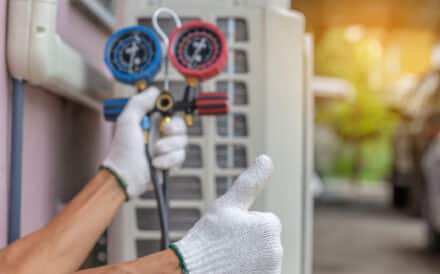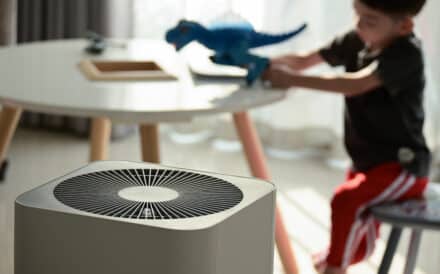The Evolution of Thermostat Technology
Four centuries ago, people began dreaming of a way to make their lives easier and more comfortable by controlling temperatures. Fast forward to today, and smart thermostat technology is used to do just that for everything from our cars and air conditioners to our furnaces, refrigerators, and more.
From simple mechanical switches to sophisticated smart home hubs, the history of thermostats gives us a peek at our ongoing quest for greater comfort, convenience, and energy efficiency. Here’s a look at how smart thermostat technology has evolved over the years.
The Beginning of Temperature Control
Believe it or not, the thermostat’s origin story all begins with chickens. In 1620, a Dutch inventor named Cornelis Drebbel created the first primitive thermostat to keep his chicken eggs warm in an incubator. However, it wasn’t until the 1830s that Scottish chemist Andrew Ure patented what we would recognize as the first modern thermostat, designed to keep steam boilers at the right temperature.
The breakthrough that brought thermostats into our homes came in 1883 when Albert Butz invented his “damper-flapper,” the first electric thermostat that automatically adjusted furnace heat. This was a major development, as families still relied on wood-burning stoves and furnaces at the time. Butz’s brilliant invention laid the groundwork for modern temperature control and eventually led to the formation of what we now know as Honeywell International.
Mechanical Marvels
For much of the 20th century, mechanical thermostats dominated home heating systems. These devices relied on physical mechanisms such as bimetallic strips, wax elements, or gas-filled tubes that would expand or contract with temperature changes. When you turned the familiar round dial of these thermostats, you were setting the point at which these materials would trigger your heating system to turn on or off.
A big leap forward came in 1906 when Mark Honeywell introduced the Jewell — the first programmable thermostat with a built-in clock. For the first time, homeowners could set their thermostats to automatically lower the heat at night and warm the house back up in the morning, all without ever leaving the comfort of their beds. This was just the first of many thermostat upgrades aimed at making our lives easier and more convenient.
The Digital Revolution
The 1980s and 90s brought us digital thermostats with LCD screens and electronic circuits, replacing mechanical parts with more precise temperature sensors. These new features could measure temperature more accurately, while also providing more programming options. This allowed users to set different temperatures for various times and days of the week.
Introducing these digital thermostats was a massive step forward in terms of precision and energy efficiency. By maintaining more consistent temperatures and allowing for smarter scheduling (like turning down the heat when everyone’s at work or school), these thermostat upgrades helped cut energy bills while keeping homes more comfortable.
The Smart Thermostat Era
The biggest transformation in smart thermostat technology kicked off in 2008 when ecobee launched the world’s first Wi-Fi-connected thermostat. A few years later, Nest introduced its Learning Thermostat that could actually adapt to your habits and preferences. In just a few years, thermostats went from following commands to having the ability to think and act independently.
Today’s smart thermostat technology can do things that would have seemed like science fiction just a decade ago:
- Control your home’s temperature from your smartphone, whether you’re on the couch or on vacation.
- Learning algorithms that adapt to your schedule and preferences so you don’t have to program anything.
- Integration with voice assistants like Alexa and Google Home, so you can simply say: “Hey Google, turn up the heat.”
- Show you reports about your energy usage and suggest ways to save
- Compatibility with other smart devices in your home for a truly connected experience.
- Monitor your indoor air quality and let you know when it’s time to change filters.
- Geofencing that adjusts temperatures based on your location. For instance, if you’re heading home from work in the winter, it can turn the heat up so your house is cozy by the time you walk in the door.
Benefits Beyond Convenience
Modern smart thermostat technology goes far beyond simply turning your heat on and off, delivering real benefits for your home, your wallet, and the planet. These benefits include:
- Energy Efficiency: Smart thermostats can slash your heating and cooling costs by 10-26% by optimizing when your system runs and eliminating wasted energy. That’s money back in your pocket year over year.
- Enhanced Comfort: Your home stays just the way you like it, with precise temperature control that adapts to your preferences.
- System Protection: Many smart models keep an eye on your HVAC system’s health, alerting you to potential problems before they turn into expensive repairs or leave you without heat on some of the coldest nights of the year.
- Environmental Impact: Using less energy isn’t just good for your wallet. It also reduces your carbon footprint. Smart thermostat technology is an easy way to make your home more eco-friendly and help contribute to sustainability efforts.
Find The Right Thermostat for Your Home
From Drebbel’s chicken incubator to today’s AI-powered climate control hubs, each new thermostat advancement gives us more control over our home environment and energy usage, making life better for our families and planet.
If you’re thinking about thermostat upgrades, contact us today. Our Silver State experts can help you discover options that will match your lifestyle and work best with your existing system.




